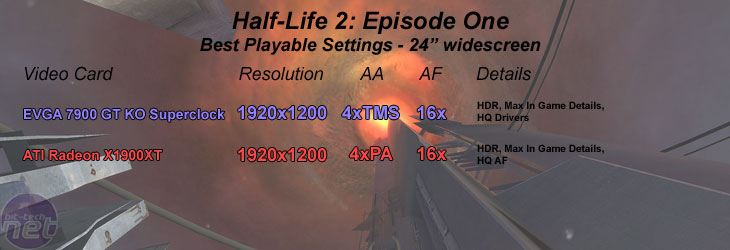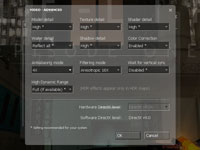For gameplay evaluations on a CRT, please head back to our CRT performance section.
Half-Life 2: Episode One is the first in a series of episodes that extends the Half-Life 2 story far beyond where the original left off. Valve has implemented its high-dynamic range rendering and used it to great effect in Half-Life 2: Episode One. There are new higher-resolution textures, new facial animations and some AI improvements made in the new game too.
Anti-aliasing and anisotropic filtering were controlled from inside the game, and thus the drivers were left set to "Application Controlled". There are three options for the method of HDR used in this title. You can either disable HDR completely, make use of "Bloom" which is just what it says and less resource hungry in comparison to "Full" which, again is just what it says. It utilises a full dynamic range with the iris effect too.
We have written quite a bit about Half-Life 2: Lost Coast, Day of Defeat: Source, Episode One and how Valve have implemented HDR in to the Source Engine. You can check out the articles listed below for more information on The Lost Coast & Day of Defeat: Source.
We did a five minute manual run through from the Exit 17 level. It involves lots of HDR, lots of explosions and both indoor and outdoor scenes. The section we have used is typical of some of the more stressful areas in the game. Thankfully though, the game runs superbly on a wide range of hardware, while still looking absolutely stunning.

 When we increased the resolution to 1920x1200, the differences in performance between the EVGA e-GeForce 7900 GT KO Superclock and ATI Radeon X1900XT started to open up a bit. The overclocked EVGA 7900 GT delivered a smooth gaming experience, but there were a couple of occasions where the frame rate dropped below 30 fps - this didn't happen once on the Radeon X1900XT as the minimum frame rate delivered by it was an impressive 31 fps.
When we increased the resolution to 1920x1200, the differences in performance between the EVGA e-GeForce 7900 GT KO Superclock and ATI Radeon X1900XT started to open up a bit. The overclocked EVGA 7900 GT delivered a smooth gaming experience, but there were a couple of occasions where the frame rate dropped below 30 fps - this didn't happen once on the Radeon X1900XT as the minimum frame rate delivered by it was an impressive 31 fps.
The average frame rate on the Radeon X1900XT was some 7 frames per second higher than EVGA's GeForce 7900 GT Superclock too. Despite these differences in frame rate, both cards were playable with the same in-game settings and AA/AF settings. Also, we were able to turn transparency multisampling on on the EVGA card and performance adaptive AA on the X1900XT.
Half-Life 2: Episode One
Publisher: Valve SoftwareHalf-Life 2: Episode One is the first in a series of episodes that extends the Half-Life 2 story far beyond where the original left off. Valve has implemented its high-dynamic range rendering and used it to great effect in Half-Life 2: Episode One. There are new higher-resolution textures, new facial animations and some AI improvements made in the new game too.
Anti-aliasing and anisotropic filtering were controlled from inside the game, and thus the drivers were left set to "Application Controlled". There are three options for the method of HDR used in this title. You can either disable HDR completely, make use of "Bloom" which is just what it says and less resource hungry in comparison to "Full" which, again is just what it says. It utilises a full dynamic range with the iris effect too.
We have written quite a bit about Half-Life 2: Lost Coast, Day of Defeat: Source, Episode One and how Valve have implemented HDR in to the Source Engine. You can check out the articles listed below for more information on The Lost Coast & Day of Defeat: Source.
- Half-Life 2: Lost Coast HDR overview
- Half-Life 2: Lost Coast hands on
- Half-Life 2: Lost Coast Benchmarks & Video
- Day of Defeat: Source
- Cinematic Effects in Source
- Liveblogging HL2: Episode One
We did a five minute manual run through from the Exit 17 level. It involves lots of HDR, lots of explosions and both indoor and outdoor scenes. The section we have used is typical of some of the more stressful areas in the game. Thankfully though, the game runs superbly on a wide range of hardware, while still looking absolutely stunning.


The average frame rate on the Radeon X1900XT was some 7 frames per second higher than EVGA's GeForce 7900 GT Superclock too. Despite these differences in frame rate, both cards were playable with the same in-game settings and AA/AF settings. Also, we were able to turn transparency multisampling on on the EVGA card and performance adaptive AA on the X1900XT.

MSI MPG Velox 100R Chassis Review
October 14 2021 | 15:04







Want to comment? Please log in.